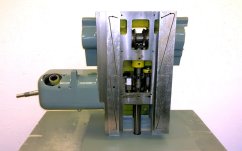I would like some general advice on adjusting a Z axis jib on a Mikron WF1 and what to do if you think the table is hard to raise and lower by the handwheel. Mechanically the Mikron setup is almost identical to the Deckel apart from one turn of the handwheel lifts the table 2mm on the Mikron and 2.5mm on the Deckel.
Having just rebuilt my machine I adjusted the jib with just the main carriage assembly in place, no X axis mount or table to give 0.04mm clearance measured with a feeler gauge.
Now with the full weight of the X axis and table in place I am somewhat surprised how much effort is required to raise and lower the table. I don’t have much experience of operating other machines apart from my FP1 which is a lot lighter in construction and much easier to crank the table up and down.
I decided to readjust the jib thinking it was too tight. I adjusted the jib until it was tight then backed off half a turn and it made no difference to the effort required to lift and drop the table.
I checked the leadscrew with all the weight off and it turns smoothly as you would expect. The leadscrew thrust bearing is fully greased, so it’s not the drive system.
I also checked the alignment of the leadscrew nut, which was fine so it’s either the friction on the slideway or the friction caused by the weight on leadscrew and nut causing the problem.
Not sure how to resolve apart from going to the gym to bulk up a bit.
Cheers Adrian.
Having just rebuilt my machine I adjusted the jib with just the main carriage assembly in place, no X axis mount or table to give 0.04mm clearance measured with a feeler gauge.
Now with the full weight of the X axis and table in place I am somewhat surprised how much effort is required to raise and lower the table. I don’t have much experience of operating other machines apart from my FP1 which is a lot lighter in construction and much easier to crank the table up and down.
I decided to readjust the jib thinking it was too tight. I adjusted the jib until it was tight then backed off half a turn and it made no difference to the effort required to lift and drop the table.
I checked the leadscrew with all the weight off and it turns smoothly as you would expect. The leadscrew thrust bearing is fully greased, so it’s not the drive system.
I also checked the alignment of the leadscrew nut, which was fine so it’s either the friction on the slideway or the friction caused by the weight on leadscrew and nut causing the problem.
Not sure how to resolve apart from going to the gym to bulk up a bit.
Cheers Adrian.
Attachments
Last edited:





